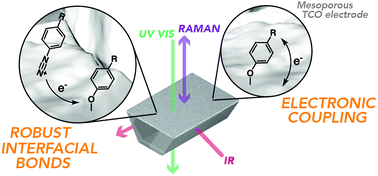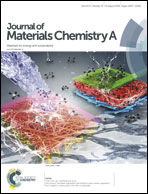Robust electrografted interfaces on metal oxides for electrocatalysis – an in situ spectroelectrochemical study†
Abstract
Diazonium salts were electrografted onto transparent conductive oxides as stable alternatives to conventional anchoring groups for the surface immobilisation of molecular species, such as molecular electrocatalysts and/or photosensitisers. Surface sensitive in situ ATR-IR spectroscopy, in combination with spectroelectrochemistry, was used as tool to provide unprecedented information on the interface formation, structure and stability, which is not possible using conventional approaches. Electrografted interfaces deposited on model oxides were thereby shown to be stable in an extraordinarily wide pH range (2.5–12) and electrochemical potential window (−0.73 to 2.23 V vs. RHE in aqueous media, and −1.3 V to 1.6 V vs. Fc/Fc+ in organic media). As a model electrocatalyst, an Fe porphyrin active for the oxygen reduction reaction (ORR) was immobilised on both mesoporous antimony doped tin oxide (me-ATO) and planar tin doped indium oxide (pl-ITO) using this electrografting approach. Surface coverages comparable to those previously reported using phosphonate anchoring groups were achieved. In addition, fast electron transfer rates were demonstrated, while in situ resonance Raman spectroelectrochemistry proved the co-ordination of the immobilised species and demonstrated its excellent electrochemical accessibility.



 Please wait while we load your content...
Please wait while we load your content...